lights RENAULT SCENIC 2010 J95 / 3.G Engine And Pheripherals DCM 1.2 Injection Workshop Manual
[x] Cancel search | Manufacturer: RENAULT, Model Year: 2010, Model line: SCENIC, Model: RENAULT SCENIC 2010 J95 / 3.GPages: 269
Page 3 of 269
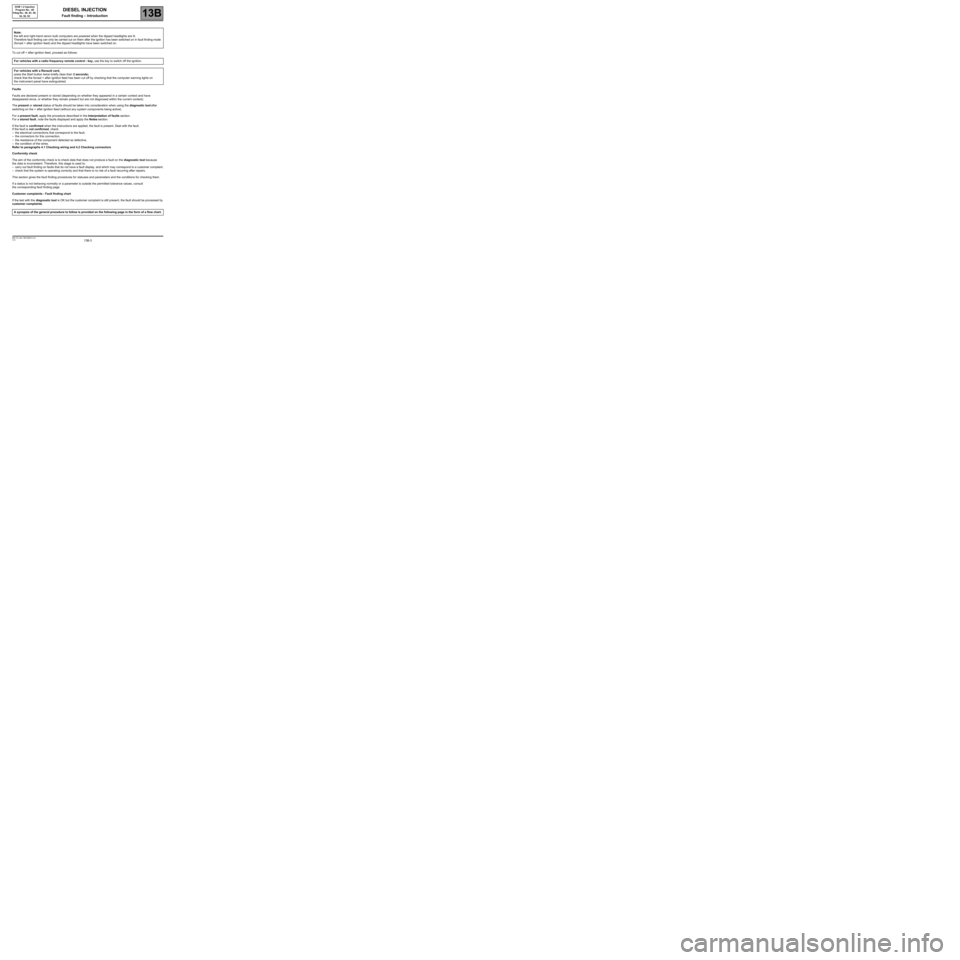
13B-3V10 MR-372-J84-13B100$010.mif
DIESEL INJECTION
Fault finding – Introduction13B
DCM 1.2 Injection
Program No.: 4D
Vdiag No.: 48, 4C, 50,
54, 58, 5C
To cut off + after ignition feed, proceed as follows:
Faults
Faults are declared present or stored (depending on whether they appeared in a certain context and have
disappeared since, or whether they remain present but are not diagnosed within the current context).
The present or stored status of faults should be taken into consideration when using the diagnostic tool after
switching on the + after ignition feed (without any system components being active).
For a present fault, apply the procedure described in the Interpretation of faults section.
For a stored fault, note the faults displayed and apply the Notes section.
If the fault is confirmed when the instructions are applied, the fault is present. Deal with the fault.
If the fault is not confirmed, check:
–the electrical connections that correspond to the fault,
–the connectors for this connection,
–the resistance of the component detected as defective,
–the condition of the wires.
Refer to paragraphs 4.1 Checking wiring and 4.2 Checking connectors
Conformity check
The aim of the conformity check is to check data that does not produce a fault on the diagnostic tool because
the data is inconsistent. Therefore, this stage is used to:
–carry out fault finding on faults that do not have a fault display, and which may correspond to a customer complaint.
–check that the system is operating correctly and that there is no risk of a fault recurring after repairs.
This section gives the fault finding procedures for statuses and parameters and the conditions for checking them.
If a status is not behaving normally or a parameter is outside the permitted tolerance values, consult
the corresponding fault finding page.
Customer complaints - Fault finding chart
If the test with the diagnostic tool is OK but the customer complaint is still present, the fault should be processed by
customer complaints. Note:
the left and right-hand xenon bulb computers are powered when the dipped headlights are lit.
Therefore fault finding can only be carried out on them after the ignition has been switched on in fault finding mode
(forced + after ignition feed) and the dipped headlights have been switched on.
For vehicles with a radio frequency remote control - key, use the key to switch off the ignition.
For vehicles with a Renault card,
press the Start button twice briefly (less than 3 seconds),
check that the forced + after ignition feed has been cut off by checking that the computer warning lights on
the instrument panel have extinguished.
A synopsis of the general procedure to follow is provided on the following page in the form of a flow chart.
Page 19 of 269
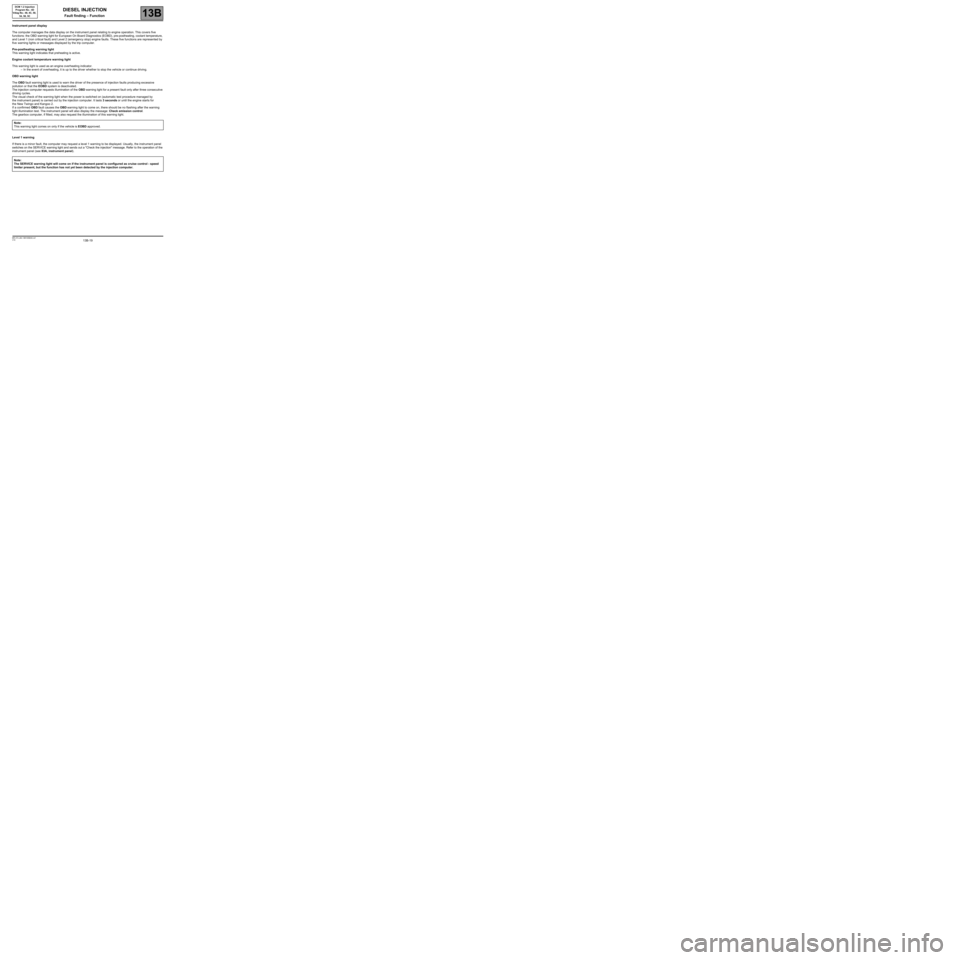
13B-19V10 MR-372-J84-13B100$040.mif
DIESEL INJECTION
Fault finding – Function13B
DCM 1.2 Injection
Program No.: 4D
Vdiag No.: 48, 4C, 50,
54, 58, 5C
Instrument panel display
The computer manages the data display on the instrument panel relating to engine operation. This covers five
functions: the OBD warning light for European On Board Diagnostics (EOBD), pre-postheating, coolant temperature,
and Level 1 (non critical fault) and Level 2 (emergency stop) engine faults. These five functions are represented by
five warning lights or messages displayed by the trip computer.
Pre-postheating warning light
This warning light indicates that preheating is active.
Engine coolant temperature warning light
This warning light is used as an engine overheating indicator.
–In the event of overheating, it is up to the driver whether to stop the vehicle or continue driving.
OBD warning light
The OBD fault warning light is used to warn the driver of the presence of injection faults producing excessive
pollution or that the EOBD system is deactivated.
The injection computer requests illumination of the OBD warning light for a present fault only after three consecutive
driving cycles.
The visual check of the warning light when the power is switched on (automatic test procedure managed by
the instrument panel) is carried out by the injection computer. It lasts 3 seconds or until the engine starts for
the New Twingo and Kangoo 2.
If a confirmed OBD fault causes the OBD warning light to come on, there should be no flashing after the warning
light illumination test. The instrument panel will also display the message: Check emission control.
The gearbox computer, if fitted, may also request the illumination of this warning light.
Level 1 warning
If there is a minor fault, the computer may request a level 1 warning to be displayed. Usually, the instrument panel
switches on the SERVICE warning light and sends out a "Check the injection" message. Refer to the operation of the
instrument panel (see 83A, instrument panel). Note:
This warning light comes on only if the vehicle is EOBD approved.
Note:
The SERVICE warning light will come on if the instrument panel is configured as cruise control - speed
limiter present, but the function has not yet been detected by the injection computer.
Page 23 of 269
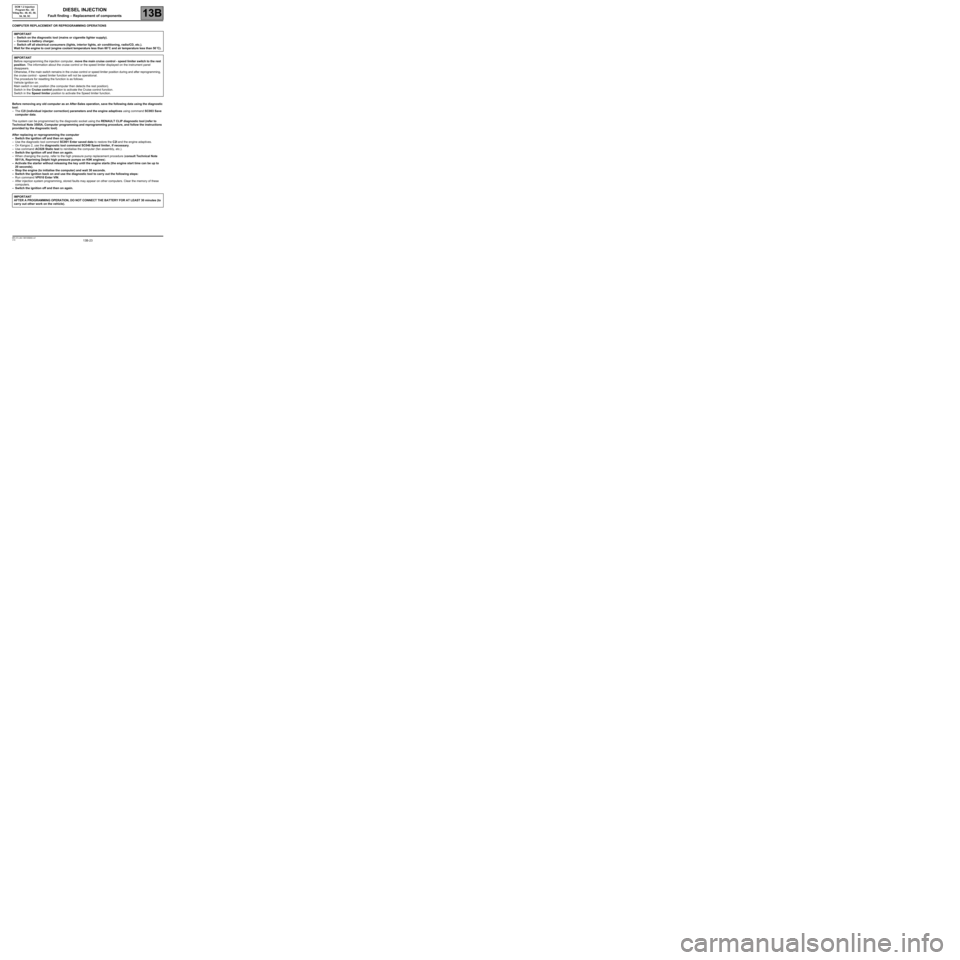
13B-23V10 MR-372-J84-13B100$060.mif
13B
DCM 1.2 Injection
Program No.: 4D
Vdiag No.: 48, 4C, 50,
54, 58, 5C
COMPUTER REPLACEMENT OR REPROGRAMMING OPERATIONS
Before removing any old computer as an After-Sales operation, save the following data using the diagnostic
tool:
–The C2I (individual injector correction) parameters and the engine adaptives using command SC003 Save
computer data.
The system can be programmed by the diagnostic socket using the RENAULT CLIP diagnostic tool (refer to
Technical Note 3585A, Computer programming and reprogramming procedure, and follow the instructions
provided by the diagnostic tool).
After replacing or reprogramming the computer
–Switch the ignition off and then on again.
–Use the diagnostic tool command SC001 Enter saved data to restore the C2I and the engine adaptives.
–On Kangoo 2, use the diagnostic tool command SC040 Speed limiter, if necessary.
–Use command AC028 Static test to reinitialise the computer (fan assembly, etc.).
–Switch the ignition off and then on again.
–When changing the pump, refer to the high pressure pump replacement procedure (consult Technical Note
5011A, Repriming Delphi high pressure pumps on K9K engines).
–Activate the starter without releasing the key until the engine starts (the engine start time can be up to
20 seconds).
–Stop the engine (to initialise the computer) and wait 30 seconds.
–Switch the ignition back on and use the diagnostic tool to carry out the following steps:
–Run command VP010 Enter VIN.
–After injection system programming, stored faults may appear on other computers. Clear the memory of these
computers.
–Switch the ignition off and then on again. IMPORTANT
–Switch on the diagnostic tool (mains or cigarette lighter supply).
–Connect a battery charger.
–Switch off all electrical consumers (lights, interior lights, air conditioning, radio/CD, etc.).
Wait for the engine to cool (engine coolant temperature less than 60
°C and air temperature less than 50°C).
IMPORTANT
Before reprogramming the injection computer, move the main cruise control - speed limiter switch to the rest
position. The information about the cruise control or the speed limiter displayed on the instrument panel
disappears.
Otherwise, if the main switch remains in the cruise control or speed limiter position during and after reprogramming,
the cruise control - speed limiter function will not be operational.
The procedure for resetting the function is as follows:
Vehicle ignition on.
Main switch in rest position (the computer then detects the rest position).
Switch in the Cruise control position to activate the Cruise control function.
Switch in the Speed limiter position to activate the Speed limiter function.
IMPORTANT
AFTER A PROGRAMMING OPERATION, DO NOT CONNECT THE BATTERY FOR AT LEAST 30 minutes (to
carry out other work on the vehicle).
DIESEL INJECTION
Fault finding – Replacement of components
Page 165 of 269
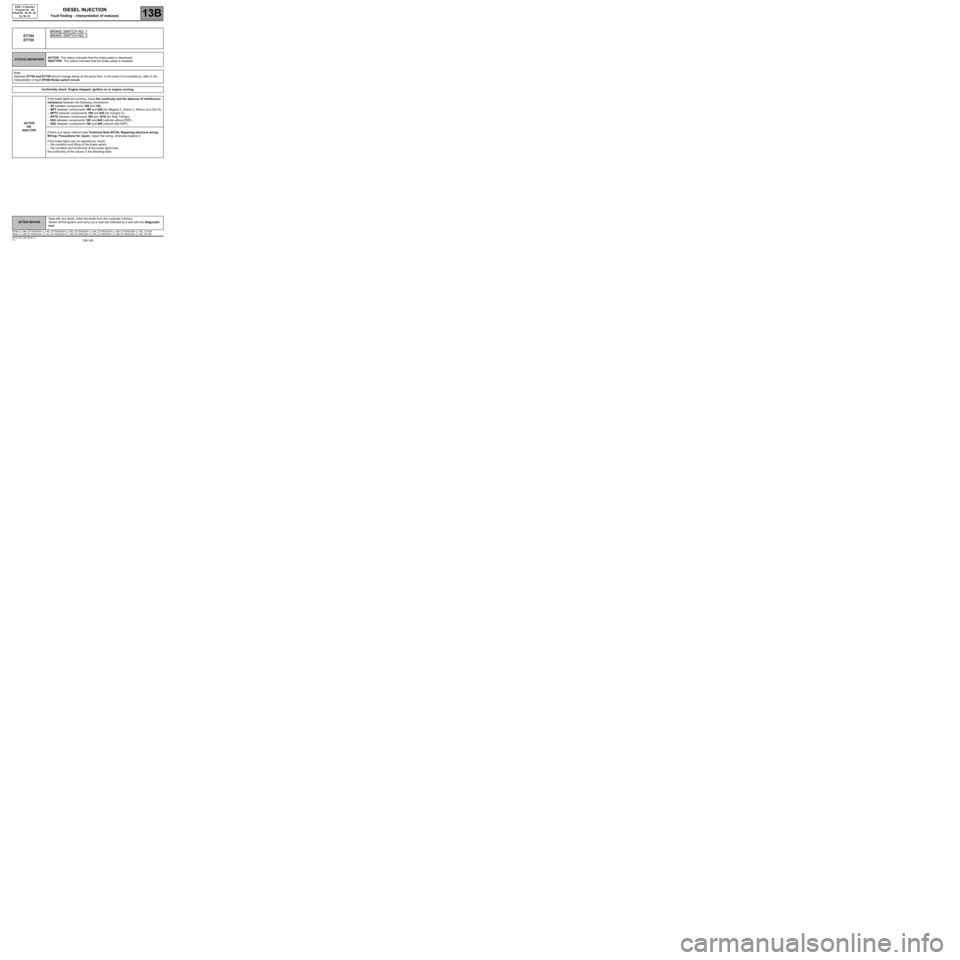
13B-165
AFTER REPAIRDeal with any faults. Clear the faults from the computer memory.
Switch off the ignition and carry out a road test followed by a test with the diagnostic
tool.
V10 MR-372-J84-13B100$150.mif
DIESEL INJECTION
Fault finding – Interpretation of statuses13B
DCM 1.2 Injection
Program No.: 4D
Vdiag No.: 48, 4C, 50,
54, 58, 5C
ET704
ET705BRAKE SWITCH NO. 1BRAKE SWITCH NO. 2
STATUS DEFINITIONACTIVE: This status indicates that the brake pedal is depressed.
INACTIVE: This status indicates that the brake pedal is released.
Note:
Statuses ET704 and ET705 should change status at the same time. In the event of inconsistency, refer to the
interpretation of fault DF050 Brake switch circuit.
Conformity check: Engine stopped, ignition on or engine running.
ACTIVE
OR
INACTIVEIf the brake lights are working, check the continuity and the absence of interference
resistance between the following connections:
–5A between components 160 and 120,
–BPT between components 160 and 645 (for Mégane II, Scénic II, Modus and Clio III),
–BPT2 between components 160 and 645 (for Kangoo 2),
–AP10 between components 160 and 1016 (for New Twingo),
–65A between components 160 and 645 (vehicle without ESP),
–65G between components 160 and 645 (vehicle with ESP).
If there is a repair method (see Technical Note 6015A, Repairing electrical wiring,
Wiring: Precautions for repair), repair the wiring, otherwise replace it.
If the brake lights are not operational, check:
–the condition and fitting of the brake switch,
–the condition and conformity of the brake lights fuse,
the conformity of the values in the following table:
DCM1.2_V48_ET704/DCM1.2_V4C_ET704/DCM1.2_V50_ET704/DCM1.2_V54_ET704/DCM1.2_V58_ET704/DCM1.2_V5C_ET704/
DCM1.2_V48_ET705/DCM1.2_V4C_ET705/DCM1.2_V50_ET705/DCM1.2_V54_ET705/DCM1.2_V58_ET705/DCM1.2_V5C_ET705
Page 185 of 269
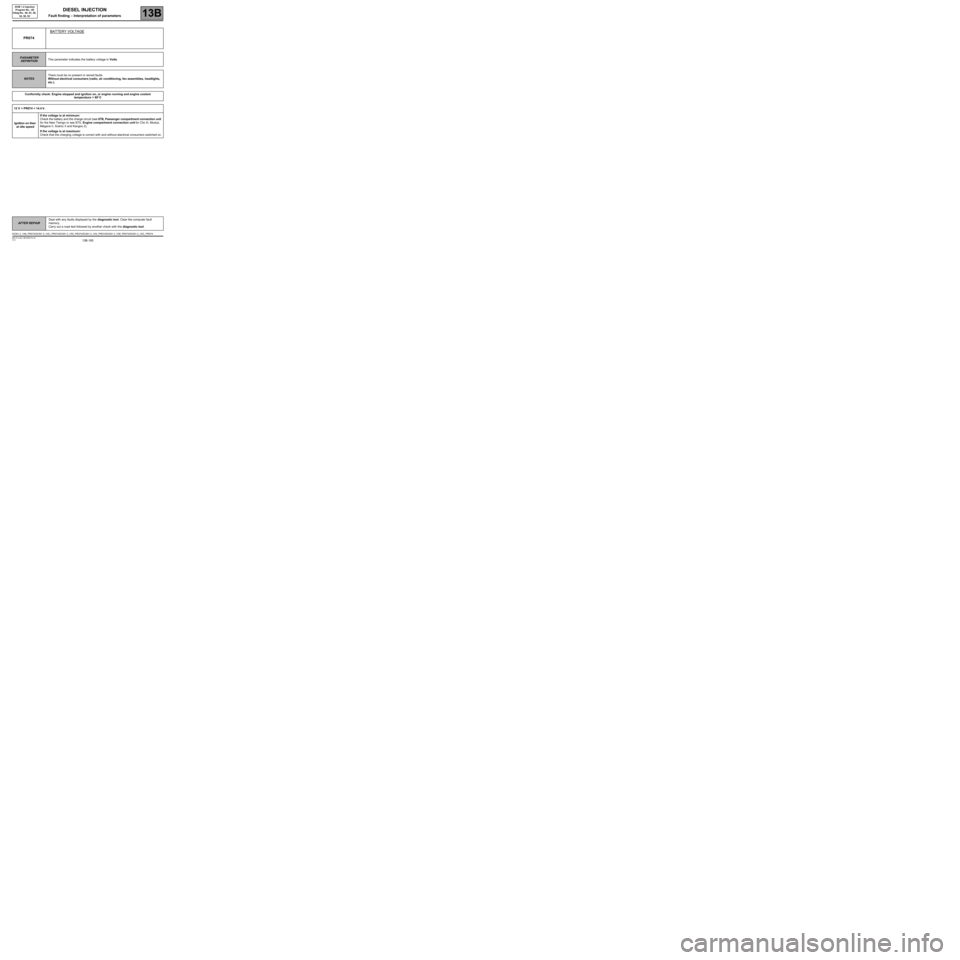
13B-185
AFTER REPAIRDeal with any faults displayed by the diagnostic tool. Clear the computer fault
memory.
Carry out a road test followed by another check with the diagnostic tool.
V10 MR-372-J84-13B100$170.mif
DIESEL INJECTION
Fault finding – Interpretation of parameters13B
DCM 1.2 Injection
Program No.: 4D
Vdiag No.: 48, 4C, 50,
54, 58, 5C
PR074BATTERY VOLTAGE
PARAMETER
DEFINITIONThis parameter indicates the battery voltage in Volts.
NOTESThere must be no present or stored faults.
Without electrical consumers (radio, air conditioning, fan assemblies, headlights,
etc.).
Conformity check: Engine stopped and ignition on, or engine running and engine coolant
temperature > 80
°C
12 V < PR074 < 14.4 V.
Ignition on then
at idle speedIf the voltage is at minimum:
Check the battery and the charge circuit (see 87B, Passenger compartment connection unit
for the New Twingo or see 87G, Engine compartment connection unit for Clio III, Modus,
Mégane II, Scénic II and Kangoo 2).
If the voltage is at maximum:
Check that the charging voltage is correct with and without electrical consumers switched on.
DCM1.2_V48_PR074/DCM1.2_V4C_PR074/DCM1.2_V50_PR074/DCM1.2_V54_PR074/DCM1.2_V58_PR074/DCM1.2_V5C_PR074